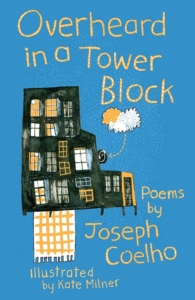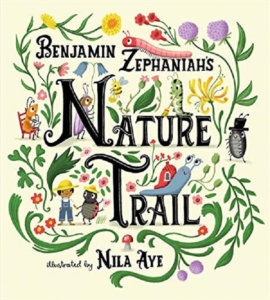
This article is in the Beyond The Secret Garden Category
Natural Environments: Belonging and Nature in British Children’s Books
The latest in our Beyond the Secret Garden series, by Karen Sands-O’Connor and Darren Chetty.
 We have discussed in previous Beyond the Secret Garden columns how the British countryside, historically and within children’s books, was a space populated and controlled by white, middle- and upper-class Britons. In Return of a Native: Learning from the Land, Vron Ware reminds us that the English countryside is itself shaped by social processes. However the assumed ‘natural environment’ for Black and Asian Britons has often not been the most obviously human-constructed spaces; densely populated urban areas. However, recent books by Black and Asian authors have begun to offer a different view of ‘nature’, the city, and belonging for British children of colour.
We have discussed in previous Beyond the Secret Garden columns how the British countryside, historically and within children’s books, was a space populated and controlled by white, middle- and upper-class Britons. In Return of a Native: Learning from the Land, Vron Ware reminds us that the English countryside is itself shaped by social processes. However the assumed ‘natural environment’ for Black and Asian Britons has often not been the most obviously human-constructed spaces; densely populated urban areas. However, recent books by Black and Asian authors have begun to offer a different view of ‘nature’, the city, and belonging for British children of colour.
In the 1960s, 70s and 80s, when children’s books began to depict a multiracial view of Britain more frequently, it was almost exclusively in an urban context. Charles Keeping, in his Kate Greenaway medal-winning Charley, Charlotte and the Golden Canary (1967) suggested that the tower block (the first of which was built in 1951) was the answer to the urban slums of London, populated by multiracial families. He creates a gleaming, golden tower block rising up above the darker slums. Although he does admit that the tower block has the power to separate people from their communities (Charlotte moves from the slum to the tower block, but Charley, the Black child, stays behind), Keeping argues that the natural world (in the form of a canary as golden as the tower block) can bring friends back together. However, Keeping’s optimistic view is countered by British African author Buchi Emecheta, who depicted the poverty and lack of access to green space for Black and working-class children in Nowhere to Play (1980). In either case, Black children have no access to green spaces, and their ‘natural environment’ is the streets.
The view of the tower block as gleaming or golden quickly disappeared, both in real life and in children’s books. Books such as Eric Allen’s The Latchkey Children (1968) showed the tower block as a place where the ‘deprived section of the community’ (10) lives, where children must make the most of the single tree in a playground. The council decides to replace the tree with a cement train, and the children must fight to save the only remaining natural element in the playground. It is the Black child and his father, who come from outside the community, who lead a strike against the killing of the tree. The children do save the tree in the end, but it remains their only connection to the natural world.
 The image of the tower block in the popular imagination has not changed very much, and was made worse by the 2017 Grenfell Tower fire in which 72 mostly poor and working-class people, many from racially-minoritised backgrounds, died and more were injured or lost their homes due to shoddy construction practices. Current children’s laureate Joseph Coehlo published his poetry collection, Overheard in a Tower Block (2017) just a month after the disaster, and his work offers a very different view of the tower block and of the children who live there, seeing both as vibrant and full of wonders. Coehlo, who grew up in a tower block himself, suggests in ‘City Kids’ that children in tower blocks are observant of everything that goes on around them—including ‘the flower-filled roadside’ and the colours of nature in the world around them. Coehlo goes further in connecting tower block children and nature in his recent picture book, Our Tower (2022). The group of tower block children, led on the front cover by a Black girl, explore the world around their tower, finding a magical world of nature that they are able to bring back to the tower in the end. By exploring the natural world that still exists near their tower, the children are able to find ‘A power that connects us all/ to an ancient tree-grown throne’. The power of nature brings the community together.
The image of the tower block in the popular imagination has not changed very much, and was made worse by the 2017 Grenfell Tower fire in which 72 mostly poor and working-class people, many from racially-minoritised backgrounds, died and more were injured or lost their homes due to shoddy construction practices. Current children’s laureate Joseph Coehlo published his poetry collection, Overheard in a Tower Block (2017) just a month after the disaster, and his work offers a very different view of the tower block and of the children who live there, seeing both as vibrant and full of wonders. Coehlo, who grew up in a tower block himself, suggests in ‘City Kids’ that children in tower blocks are observant of everything that goes on around them—including ‘the flower-filled roadside’ and the colours of nature in the world around them. Coehlo goes further in connecting tower block children and nature in his recent picture book, Our Tower (2022). The group of tower block children, led on the front cover by a Black girl, explore the world around their tower, finding a magical world of nature that they are able to bring back to the tower in the end. By exploring the natural world that still exists near their tower, the children are able to find ‘A power that connects us all/ to an ancient tree-grown throne’. The power of nature brings the community together.
Coehlo’s depiction of a multiracial group of children who belong both to the tower and to the natural world is important in reinforcing the idea  that nature belongs to everyone. This is an idea that also is central to Benjamin Zephaniah’s Nature Trail (2022) in which a small brown child explores the natural world in a garden, concluding ‘And I believe we all deserve/ A garden of our own’. Rather than being contained outside of nature and in a gritty urban centre, Zephaniah’s child is in a space—a garden—that is normally considered a way of containing nature. But Zephaniah’s child discovers that the garden contains more nature than first meets the eye. The ‘garden of our own’ that Zephaniah suggests all children deserve is depicted in illustrations by Nila Aye as a playground—that childhood place that combines human- and nature-constructed space.
that nature belongs to everyone. This is an idea that also is central to Benjamin Zephaniah’s Nature Trail (2022) in which a small brown child explores the natural world in a garden, concluding ‘And I believe we all deserve/ A garden of our own’. Rather than being contained outside of nature and in a gritty urban centre, Zephaniah’s child is in a space—a garden—that is normally considered a way of containing nature. But Zephaniah’s child discovers that the garden contains more nature than first meets the eye. The ‘garden of our own’ that Zephaniah suggests all children deserve is depicted in illustrations by Nila Aye as a playground—that childhood place that combines human- and nature-constructed space.
Both Ken Wilson-Max’s Eco Girl (2023) and Dapo Adeola and Nathan Bryon’s Clean Up! (2020) suggest that nature is more than just a place to play or observe, but something we all have responsibility to nurture. Clean Up! has its protagonist, a girl named Rocket, visiting grandparents in the Caribbean. Rather than the sunny paradise depicted in many previous children’s books, Bryon and Adeola show the ways that nature has been destroyed by human carelessness. Rocket is appalled by the destruction of the beach habitat through littering, and she rallies friends, family and strangers to clean up the beach so that everyone, including the plant and animal life, can thrive. Wilson-Max’s Eve, who wants to be like a tree, is given a seed to plant from her grandmother so that the African forest will continue to grow and survive for many years to come.
This responsibility for nature is even more urgent in books for older readers. Sita Brahmachari’s Where the River Runs Gold (2019) examines a world in which bees have been destroyed and child labour is required to pollinate food crops. The symbols of the broken land are trees: the massive agora tree sculpture in the centre of the city, and the illegal ‘graffitrees’ painted by defiant artists. Neither type of tree is real, but the graffitrees offer memory and hope. As Shifa says, ‘The Graffitree blossom has a thousand times more life in it than this [the tree sculpture]’ (28). Shifa and her twin Themba, must face danger to escape their captivity and bring the balance of nature back. Brahmachari’s book posits children not only as caretakers of nature, but as the only ones who can fix the mistakes and carelessness of people in the past. It is not just important for all British children, including children from racially-minoritised backgrounds, to see themselves as ‘belonging’ in nature, it is imperative for us all to survive.
Karen Sands-O’Connor is the British Academy Global Professor for Children’s Literature at Newcastle University. Her books include Children’s Publishing and Black Britain 1965-2015 (Palgrave Macmillan 2017).
Darren Chetty is a teacher, doctoral researcher and writer with research interests in education, philosophy, racism, children’s literature and hip-hop culture. He is a contributor to The Good Immigrant, edited by Nikesh Shukla and the author, with Jeffrey Boakye, of What Is Masculinity? Why Does It Matter? And Other Big Questions. He tweets at @rapclassroom.
Books mentioned:
Overheard in a Tower Block, Joseph Coelho, illus Kate Milner, Otter-Barry Books, 978-1910959589, £7.99 pbk
Where the River Runs Gold, Sita Brahmachari, Orion Children’s Books, 978-1510105416, £7.99 pbk
Our Tower, Joseph Coelho, illus Richard Johnson, Frances Lincoln, 978-0711268821, £12.99 hbk
Nature Trail, Benjamin Zephaniah, Orchard Books, 978-1408361252, £12.99 hbk
Eco Girl, Ken Wilson-Max. Otter-Barry Books, 978-1913074319, £12.99 hbk
Clean Up!, Nathan Bryon, illus Dapo Adeola, Puffin, 978-0241345894, £7.99 pbk





